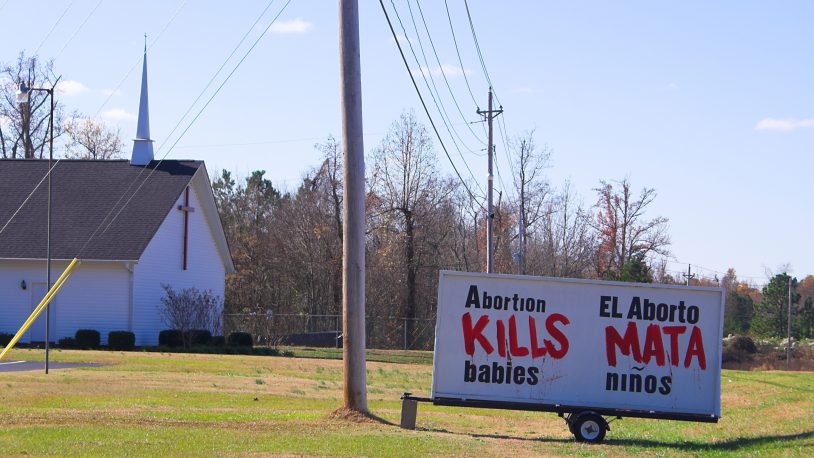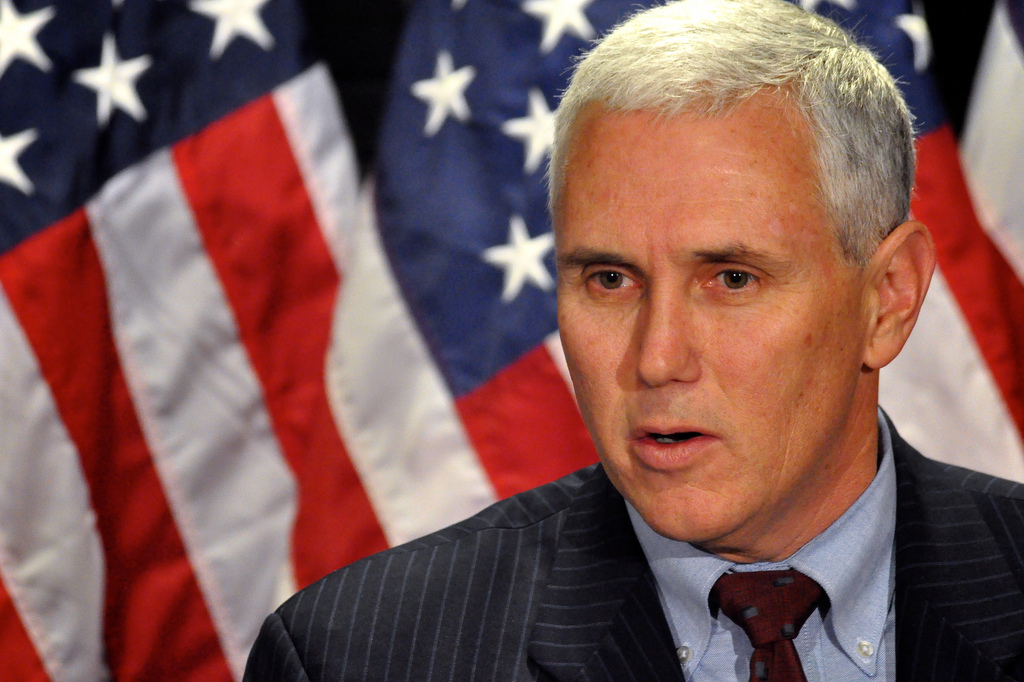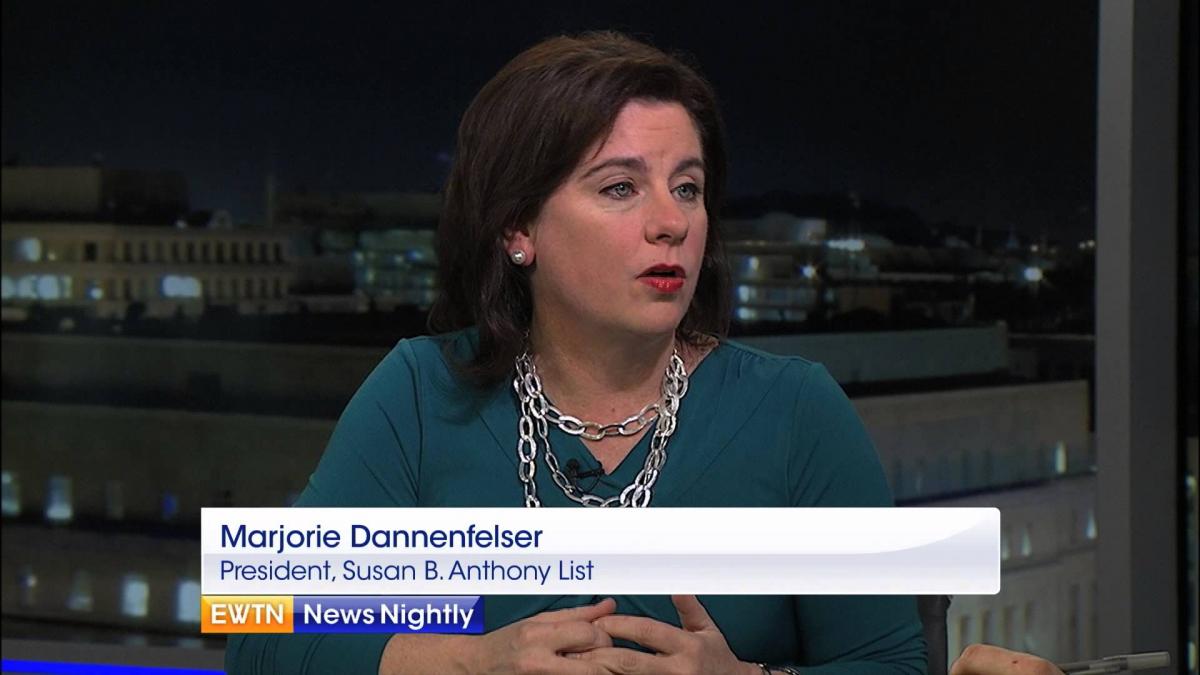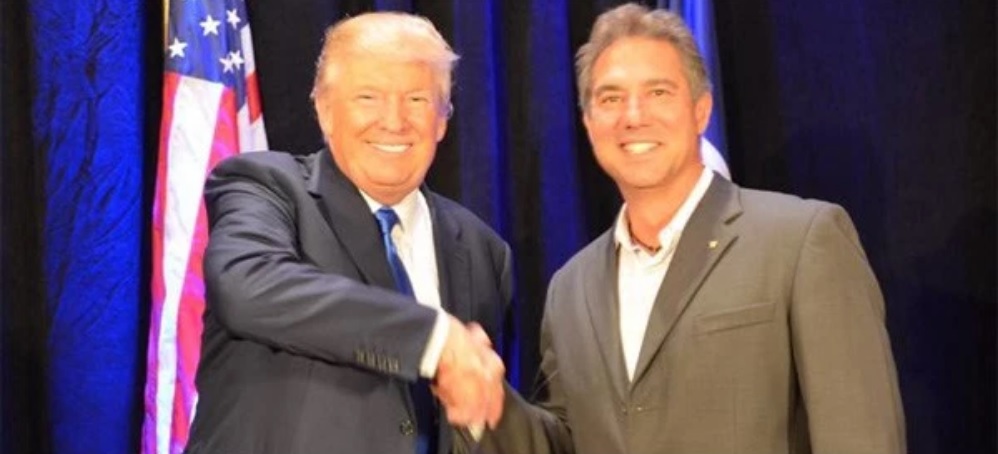“Welcome to the future of the pro-life movement.”
As a few dozen activists walked into a conference hall in an Atlanta suburb in October 2014, they were met with an optimistic greeting from an impromptu welcoming committee.
It was the founding convention of the Personhood Alliance, an association of anti-abortion groups from 15 states who are determined to wrest back an anti-choice movement that they fear has gone dangerously astray.
The members of the Personhood Alliance felt betrayed.
The largest and best-funded groups opposing abortion rights have, over the past several years, achieved astounding success in chipping away at women’s access to legal abortion in the United States. But these successes, Personhood Alliance’s founders maintain, are too small and have come at a grave cost.
In seeking mainstream approval for anti-choice politics, personhood advocates believe, groups like the National Right to Life Committee (NRLC) and Americans United for Life (AUL) have adopted a secular tone and downplayed their Christian origins. In focusing on drawing attention to issues like late-term abortion, they may have won some support for the cause but have done little to end the procedures they targeted. In seeking incremental successes, personhood advocates argue, the movement has given up on making a moral argument for the humanity of fertilized eggs and fetuses and lost sight of its larger goal of eliminating legal abortion entirely.
But the greatest betrayal in the eyes of these personhood advocates is the willingness of major anti-choice groups to endorse legislation that includes exceptions for pregnancies resulting from rape and incest. The personhood movement’s leaders contend that these political concessions are not only immoral and intellectually inconsistent, but also threaten to undermine the movement’s goals in the long term. In fact, the Personhood Alliance grew out of a feud between Georgia Right to Life leader Daniel Becker and NRLC centered around a rape exception inserted into a national 20-week abortion ban. Becker and his allies believe that they have a better plan, one that does not require compromise.
Joining the activists at the founding conference was Ben DuPré, the chief of staff for Alabama Supreme Court Chief Justice Roy Moore, who, along with his colleague Justice Tom Parker, has outlined an alternate strategy for eliminating legal protections for abortions in the United States: building a body of laws that define fertilized zygotes and fetuses as citizens with full rights under the law.
On the first night of the Personhood Alliance’s founding convention in October, Paul Broun, then a Republican congressman from Georgia, captured the activists’ anger at the leaders of the anti-choice movement, charging that they had betrayed the movement’s core principles to such a degree that they had provoked the wrath of God—and implying that they were doing so for personal gain.
Broun told the activists of a meeting he had with two leaders of NRLC when he was running for U.S. Congress in 1996. He told them that were he elected, the first bill he would introduce would be a Sanctity of Human Life Act giving personhood rights to fertilized eggs, because “how we’re going to overturn Roe v. Wade is by giving the right of personhood to that one-celled human being.” The NRLC leaders, Broun said, told him they wouldn’t support the measure, and he “walked away very disillusioned.”
When an audience member asked Broun why he thought NRLC and other major anti-choice groups weren’t putting their energy behind personhood bills, including one that he helped write, Broun responded that he wasn’t “making any accusations here,” but implied that “pro-life” leaders have a financial incentive to never achieve their declared goal.
Harkening back to that 1996 meeting, he drew a historical parallel:
They never told me [why they wouldn’t back the Sanctity of Human Life Act]. I asked them, and they just said, well, we won’t. And I walked away from that meeting in 1996 very, very disappointed, very disillusioned. And shortly after, actually as I was riding away in a taxi cab, it came to mind, back when I was a kid—looking around the room, I’m not sure anybody’s old enough to remember polio—but when I was a kid I had classmates who got polio who were in iron lungs, and I had patients as a doctor, people who when I was in medical school, were people who had polio.
The biggest charity in this country was an organization called March of Dimes. And they were, their executives were, I guess, I’m not sure, but they were making lots of money, March of Dimes was probably the biggest charity in the country. And a doctor by the name of Jonas Salk developed a vaccine. And suddenly, March of Dimes went broke.
And I went away from that meeting with National Right to Life and I was wondering, I still wonder, I’m not making any accusations here: If we were to stop abortion, what would happen to the jobs of all those people who are getting paid every day to be in the pro-life movement? What would happen? I don’t know if that’s what it is or not, I’m not making any accusations, I’m just telling you what my thought was when I left that meeting.
Broun told the Personhood Alliance that every day that legal abortion continues, America risks God’s judgment. Discussing his 2013 refusal to vote for a 20-week ban to which the House GOP had added a rape exception at the last minute, Broun said:
If we can save some, let’s do it, but let’s not make exceptions and [say] that some babies are worth killing and some are not. They’re all worth saving.
And then it goes back to ‘my people are destroyed for lack of knowledge,’ as we hear [from] Hosea 4:6, and that’s the reason education is so important. Because we’ve got to educate the grassroots.…
You see, God is a holy, righteous God. He cannot continue to bless America while we’re killing over a million babies every single day. Abortion must stop.
(Broun’s estimate of one million abortions taking place every day is, to say the least, wildly exaggerated.)
Broun argued that groups like the NRLC are selling the movement short by accepting political compromise bills containing rape and incest exceptions, and then pressuring anti-choice lawmakers to vote for those bills.
“The reason a lot of pro-life people are willing to compromise is because of that outside pressure,” he said. “Whether it’s an endorsement from Concerned Women [for America] or the Family Research Council or another group, or it could be an endorsement of the U.S. Chamber [of Commerce] or it could be the endorsement of any group. Politicians, the major principle that they will not budge from is their reelection. So they will do whatever it takes to get the endorsements, the money that they need to raise.”
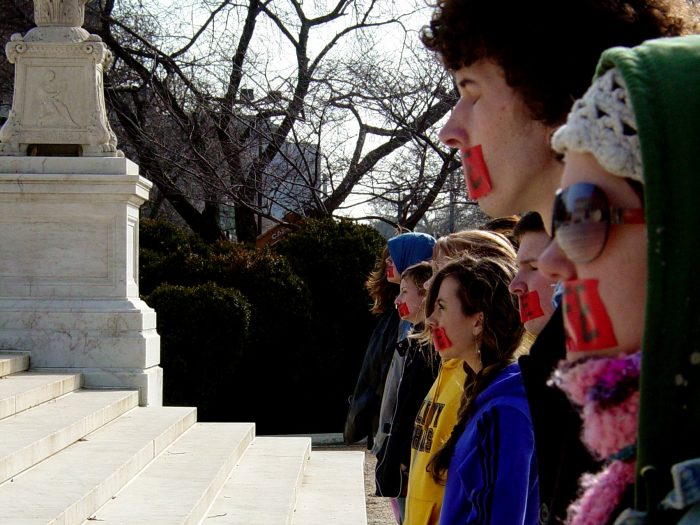
Barry Loudermilk, a former Georgia Republican state senator who had recently been elected to the U.S. House, also spoke to the convention, comparing the fight against abortion rights to the struggle of America’s founders, who he said also witnessed “a decline in the moral sensitivity of our nation.” Loudermilk, who while serving in the state senate introduced a personhood amendment that was backed by Georgia Right to Life and Tony Perkins of the Family Research Council, said, “When you look at our movement, we have the exact same things against us that they had against them,” he said. “They had the government against them, the laws, the judges. We don’t have the people who are totally with us, it’s growing. But we have the truth with us. We have Providence with us.”
The congressmen echoed a founding tenet of the Personhood Alliance: that in a movement that was increasingly struggling to appear secular, the organization would be unabashedly “Christ-centered” and “biblically informed.”
As personhood’s proponents like to remind their fellow activists, both sides of the movement share the same goal: to completely criminalize abortion. The question is just how to do it.
The largest and best-funded anti-choice groups, deploying a strategy of chipping away at abortion access in the name of “women’s health,” have pushed state legislatures to pass over 200 new restrictions on abortion rights since 2011, many based on model legislation from AUL and NRLC. This strategy has managed to shut down abortion providers (especially in rural areas), make it harder for low-income women to pay for abortion, and erect unnecessary logistical hurdles even for those women who can access and afford abortion care.
The movement also won a pivotal court case with the Supreme Court’s ruling that private corporations could deny their employees legally mandated health insurance coverage for contraceptives that the corporations’ owners believe cause abortion. And they did this all while stemming the loss in public opinion that had hindered other “culture war” issues, in part by lifting up female leaders and adopting woman-centered empowerment rhetoric.
But at the same time, another side of the anti-choice movement, those eschewing compromise and incrementalism and pursuing the goal of establishing legal “personhood” from the moment of conception, have suffered a series of embarrassing electoral blows. In 2014, Colorado voters overwhelmingly rejected a ballot measure that would have defined zygotes and fetuses as persons in the state’s criminal code. It was the third time in six years that voters in the state had rejected a “personhood” measure, although its proponents noted that their margin of defeat got smaller each time. Perhaps even more galling for the movement, voters in reliably conservative North Dakota rejected an amendment to provide constitutional protections for “every being at every stage of development” by a whopping 28-point margin. And this all came three years after a personhood initiative was soundly defeated in deep-red Mississippi.
These personhood measures, while sharing the same ultimate goal as the incremental strategy, have become widely seen as politically toxic, in large part because they could threaten access to common forms of birth control. The no-compromise strategy has also become tied to a series of ham-handed comments made by male politicians—most infamously former Missouri Rep. Todd Akin—which further hurt the personhood movement while providing political cover to those pursuing a more incremental approach.
But despite their spectacular losses at the ballot box, personhood movement strategists maintain that not only is their strategy the morally sound and intellectually consistent one—they believe their strategy is the one that will ultimately swing public opinion and overturn Roe v. Wade.
A Schism over Rape Exceptions
In January 2015, the Republican Party was forced into yet another uncomfortable public conversation about abortion and rape.
The House GOP, enjoying a strengthened majority after the 2014 elections, announced that on the anniversary of Roe v. Wade it would hold a vote on a bill banning abortion after 20 weeks of pregnancy, a top priority of groups like NRLC and AUL, which see it as a legislative key to imploding Roe v. Wade.
The night before the House was set to vote on the bill, GOP leaders pulled it from the floor, citing concerns by Republican women that a clause exempting rape survivors from the ban would require survivors to first report their assault to the police—a stipulation that they argued would prevent women from reporting rapes and would be politically unpopular.
Some anti-choice groups, however, had already stated that they would not support the bill—because they believed that the rape exception violated the principles of the anti-choice movement by exempting some women from abortion prohibitions.
In fact, two years earlier, the addition of the rape exemption to the bill had caused an acrimonious public split in the anti-choice movement, leading to the formation of the newest group advocating for a “personhood” strategy to end legal abortion.
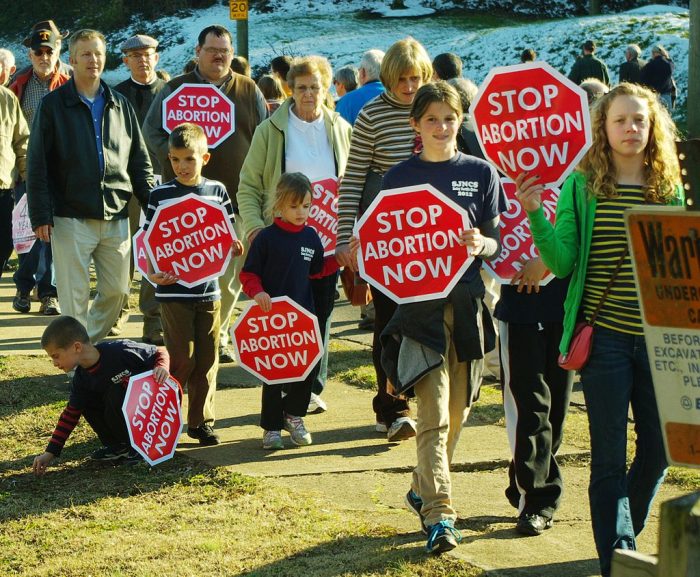
The 2013 bill, proposed by Republican Rep. Trent Franks of Arizona, included an exception only for abortions that would save the life of a pregnant woman. But in a committee hearing on the bill, Franks caused an uproar when he defended his bill by claiming that rape rarely results in pregnancy anyway. House Republicans, facing another outrageous comment about rape from one of their own, quickly added a rape exception to the bill; put a female cosponsor, Rep. Marsha Blackburn, in charge of the floor debate; and pushed it through the House.
The day before the vote, NRLC sent members of Congress a letter calling the Franks bill, which was based on its own model legislation, “the most important single piece of pro-life legislation to come before the House since the Partial-Birth Abortion Ban Act was enacted, a full decade ago.”
The group told members of Congress that it would go after them if they voted against the bill, even if they opposed it because they thought the legislation did not go far enough: “NRLC will regard a vote against this legislation, no matter what justification is offered, as a vote to allow unlimited abortion in the sixth month or later—and that is the way it will be reported in our scorecard of key right-to-life roll calls of the 113th Congress, and in subsequent communications from National Right to Life to grassroots pro-life citizens in every state.”
Major anti-choice groups, including the Susan B. Anthony List and Americans United for Life, also applauded the vote.
But Daniel Becker, head of National Right to Life’s Georgia affiliate, was not pleased. In the days after Republicans added a rape exception to the bill, Becker worked the phones, urging House Republicans from his state to oppose the “shameful” legislation. His efforts convinced two Georgia Republicans, Rep. Paul Broun and Rep. Rob Woodall, to buck their party and the major anti-choice groups and vote against the bill. Georgia Right to Life then endorsed Broun in his unsuccessful campaign to win the GOP nomination for an open U.S. Senate seat.
NRLC was livid and, true to its word, sent out a press release the next day singling out Broun and Woodall for their no votes.
Also furious was a prominent NRLC ally in Georgia, conservative pundit Erick Erickson. The day that the House approved the 20-week ban, Erickson wrote a scathing blog post calling Becker’s group “the Westboro Baptist Church of the pro-life movement.”
“Instead of saving souls, they’d rather stone those who are trying to save souls,” Erickson wrote. He called for the formation of a new pro-life group in Georgia to replace Becker’s group in NRLC.
Several months later, in time for an upcoming meeting of NRLC’s board, Erickson founded his own group, Georgia Life Alliance. He then asked the national group to disaffiliate itself from Georgia Right to Life and take his group on as its official state chapter. NRLC’s board happily complied, saying that Becker’s group’s defiance on the Franks bill had “ruptured its relationship” with them.
It didn’t take long for Becker to strike back. Less than three months later, Georgia Right to Life announced that it was forming the National Personhood Alliance, a new national organization of anti-abortion groups committed to a “no exceptions” strategy. (The group was later renamed “Personhood Alliance.”) In a press release announcing the group’s formation, he laid out the alliance’s philosophy, including a thinly veiled attack on NRLC. “Compromise is not possible,” he wrote. “This is not like roads or highways or agricultural subsidies; when we compromise—someone dies.”
In a policy paper in June, Jay Rogers of Personhood Florida laid out the new alliance’s strategy. It would not oppose incremental measures like the 20-week ban, but it would oppose any measure that “identifies a class of human beings that we may kill with impunity.” That is, it would only support efforts to restrict abortion rights that contain no exceptions whatsoever, including for rape, incest or to preserve the health of a pregnant woman.
Becker announced that the group’s interim president would be another anti-choice activist who had broken ranks with NRLC over strategy—in this case, over LGBT rights. Molly Smith, the president of Cleveland Right to Life, had earned a rebuke from NRLC when she said her group would oppose the reelection of Ohio Republican Sen. Rob Portman after he came out in favor of marriage equality, citing his openly gay son. NRLC blasted Smith for opposing the staunchly anti-choice senator and taking on “an advocacy agenda that includes issues beyond the right to life.”
The new group won endorsements from prominent Religious Right activist Mat Staver of Liberty Counsel, popular conservative talk show host Steve Deace and Irish anti-abortion organization Life Institute.
But it also displayed ties to more fringe activists, boasting of an endorsement from infamous abortion clinic agitator Rusty Lee Thomas of Operation Save America, who blames the September 11 attacks on legal abortion. Jay Rogers, who wrote the Personhood Alliance’s manifesto, is a longtime ally of Operation Save America who once assisted the group by administering a website showing the locations of Florida abortion providers’ private homes.
Another founding member of Personhood Alliance was Les Riley, who spearheaded Mississippi’s failed personhood amendment in 2011. Riley is a one-time blogger for a group that advocates Christian secession from the U.S. and a current officer with the theocratic Mississippi Constitution Party. Georgia’s Constitution Party sponsored a booth at the Personhood Alliance’s convention.
Becker himself has a history on the radical, confrontational fringes of the anti-abortion movement. In 1992, while running for a House seat in Georgia, Becker gained national attention when he helped pioneer the strategy of using an election-law loophole to run graphic anti-abortion ads on primetime television.
The schism that brought about the creation of the Personhood Alliance is just the latest in a long history of disputes within the anti-choice movement over how to best confront Roe v. Wade and what compromises to accept in pursuit of that goal.
How to Overturn Roe?
As proponents of the “personhood” strategy to end legal abortion like to remind those who will listen, the original goal of the anti-abortion rights movement after Roe v. Wade was to pass a constitutional amendment overturning the decision. And one possible amendment—along with a dubious statutory alternative—would have done so by defining “personhood” as starting at conception.
In the 1970s and 1980s, dozens of anti-Roe “Human Life Amendments” were introduced in Congress, containing a variety of language. Only one made it to an up-or-down vote in Congress: the Hatch-Eagleton Amendment, which would have simply gutted Roe by stating, “A right to abortion is not secured by this Constitution.” In June 1983, the amendment fell far short of the two-thirds majority needed for a constitutional amendment, garnering just 49 yes votes.
But there was another strategy for amending the Constitution to reverse Roe, one that, rather than just returning to the states the power to regulate abortion, would have overturned Roe by declaring that fetuses are “persons” protected under the Constitution. In 1976, one such amendment was put up for a test vote in the Senate, garnering only 40 votes in support.
The language of these amendments was a matter of bitter internal debate among anti-abortion rights groups. One draft amendment formulated by the National Right to Life Committee in 1974, known as the NRLC Amendment, would have declared that the word “person” in the Fourteenth Amendment and Fifth Amendment “applies to all human beings irrespective of age, health, function, or condition of dependency, including their unborn offspring at every stage of their biological development,” but included a specific exemption for “medical procedures required to prevent the death of the mother.”
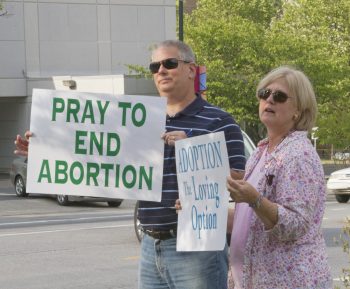
Some members of NRLC’s budding coalition thought the amendment didn’t go far enough to prohibit abortion, arguing that the “life of the mother” exception was too broad. Two founding NRLC members, Judie and Paul Brown, left the group because they perceived it as too willing to compromise. They founded their own anti-choice group, the American Life League (ALL), and helped to establish the radical abortion “rescue” movement. In 1979, ALL wrote its own amendment, nicknamed the “Paramount Amendment,” which would have erased all abortion exceptions by declaring, “The paramount right to life is vested in each human being from the moment of fertilization without regard to age, health, or condition of dependency.”
Faced with a splintering movement, NRLC held months of talks with its fellow anti-abortion groups, hoping to hammer out a Human Life Amendment that they could unify behind. In October 1981, NRLC announced that “with tears of joy and happiness” it had “solved what formerly appeared to be an irreconcilable difference over a fundamental question: how to allow for just those abortions truly needed to prevent the death of the mother without at the same time making her right to life superior to that of her unborn child.”
NRLC’s new Unity Amendment, which was introduced by Sen. Jesse Helms of North Carolina that December, tightened the “life of the mother” exception by adding the stipulation that abortion would be allowed only to “prevent the death of either the pregnant woman or her unborn offspring, as long as such law requires every reasonable effort be made to preserve the life of each.”
All of these amendments failed to get off the ground, as did a novel and controversial legislative approach to achieve the same goal. In 1981, Helms and Sen. Henry Hyde introduced a bill that they claimed could overturn Roe without a constitutional amendment or a new Supreme Court majority, by simply declaring that life begins “at conception.” The effect of the law, the New York Times reported at the time, would be to once again allow “states, if they choose, to prosecute abortion as murder.” President Reagan got behind the strategy, but legal scholars called the bill unconstitutional. NRLC and the National Conference of Catholic Bishops continued to favor the constitutional amendment strategy, doubting that the Helms-Hyde bill would hold up in the courts.
By that time, however, it became clear that a constitutional amendment and the Helms-Hyde personhood bill weren’t going anywhere in Congress, and proponents had already started focusing on other strategies to turn back the tide on abortion rights.
'Prune the Abortion Weed and Sanction Its Root'
In 1975, the National Conference of Catholic Bishops developed a plan to turn every diocese into an anti-choice political machine and to use its existing infrastructure to set up an office in every congressional district. The bishops’ plan included a four-pronged legislative strategy, which continues to guide the anti-choice movement today:
(a) Passage of a constitutional amendment providing protection for the unborn child to the maximum degree possible.
(b) Passage of federal and state laws and adoption of administrative policies that will restrict the practice of abortion as much as possible.
(c) Continual research into and refinement and precise interpretation of Roe and Doe and subsequent court decisions.
(d) Support for legislation that provides alternatives to abortion.
In other words: fight for an amendment to undo Roe, but at the same time work through the courts and legislatures to make it harder for women to access legal abortion. While Roe would remain the law of the land, women would not be able to actually exercise their rights.
Part of this strategy involved targeting public funding for abortions. Frederick Jaffe, Barbara Lindheim and Philip Lee explained in their 1981 book “Abortion Politics”:
The new strategy was outlined by RTL [right to life] leader Randy Engel, who urged restrictive riders on “any and all federal legislation related directly or indirectly to health,” in order to keep the abortion issue visible and build support. She argued that the efforts to win interim legislation would provide anti-abortion workers with political experience, would educate the public, and would force members of Congress to go on record one way or the other. Not least important, she added, this strategy would require the forces supporting abortion rights to expend time, effort and resources in opposing riders.
One of the early victories of this strategy was the 1976 passage of the Hyde Amendment, a rider to the Health and Human Services spending bill that prohibited Medicaid from funding abortions for low-income women. The Hyde Amendment was a victory, but it provoked yet more squabbling within the anti-abortion rights movement.
When it was first passed, the Hyde Amendment contained one exception: for abortions that could save the life of a “clearly endangered” pregnant woman. But because it was attached to a spending bill, the Hyde Amendment had to be renewed annually. The next year, after a lengthy legislative deadlock, Congress kept the exception for saving a woman’s life and added additional exceptions for ensuring a woman’s long-term health and for pregnancies resulting from rape or incest.
The 1977 compromise allowing abortion funding for rape and incest survivors—which has been modified several times since then—was a setback for anti-choice hardliners, but the anti-abortion rights movement’s leaders continue to celebrate the Hyde Amendment’s repeated renewal. In 2013, on the amendment’s anniversary, National Right to Life crowed that “over one million people are alive today because of the Hyde Amendment.”
But Daniel Becker, a longtime personhood activist and founder of the new Personhood Alliance, sees it differently. “The Hyde Amendment,” Becker wrote in his 2011 book on the personhood concept, “damaged the very fabric of our mission. No longer would the lofty rhetoric of ‘sanctity of all human life’ and ‘the personhood of the unborn’ be embodied in a strategy to achieve those protections. The pro-life movement had a seat at the political table, but contented itself with crumbs.”
In 2007, the anti-choice movement achieved another seeming victory that was divisive in its own ranks. The Supreme Court, which now included George W. Bush appointees John Roberts and Samuel Alito, reversed a previous decision and upheld the 2003 ban on a specific procedure that the anti-choice movement had labeled “partial-birth abortion.”
Linda Greenhouse wrote in the New York Times that the decision, Gonzales v. Carhart, was a “vindication” of the anti-choice movement’s strategy of pursuing a “partial-birth abortion” ban after the 1992 Planned Parenthood v. Casey decision made a more sweeping victory look unfeasible: “By identifying the … procedure and giving it the provocative label ‘partial-birth abortion,’ the movement turned the public focus of the abortion debate from the rights of women to the fate of fetuses.”
Linda Greenhouse, New York Times
As with the congressional fight over abortion coverage in Medicaid, abortion rights opponents hoped to use the debate over so-called “partial-birth abortion,” an exceedingly rare procedure, to keep attention on their efforts to end legal abortion entirely.
But not everybody in the anti-choice movement was thrilled. In fact, the decision that was widely seen as a victory for the anti-choice movement brought into the public eye a long-simmering split in the movement.
Six weeks after Gonzales was handed down, a coalition of anti-abortion groups, including the Colorado chapter of National Right to Life, took out a full-page ad in newspapers around the country attacking Focus on the Family founder James Dobson for supporting the ruling.
One Denver pastor in the group, Bob Enyart, accused mainstream pro-life groups of fundraising off a strategy that “has no authority to prevent a single abortion” because other procedures could be used in place of the banned operation. Colorado Right to Life President Brian Rohrbough told the Washington Post, “What happened in the abortion world is that groups like National Right to Life, they’re really a wing of the Republican Party, and they’re not geared to push for personhood for an unborn child—they’re geared to getting Republicans elected. So we’re seeing these ridiculous laws like the Partial-Birth Abortion Ban put forward, and then we’re deceived about what they really do.”
As the Post noted, NRLC’s detractors started referring to the group as the “pro-life industry”—a term intentionally reminiscent of the anti-choice movement’s “abortion industry” epithet for abortion providers, implying that those groups had sold out and cared more about their fundraising than their mission. (Several years later, Rep. Paul Broun of Georgia used similar rhetoric to question the group’s motives.)
A week later, leaders of Colorado Right to Life confronted the board of NRLC at its annual meeting, attacking its “immoral and failed anti-abortion strategy.” Enyart told the board, in a speech secretly recorded by Colorado Right to Life:
We’ve provided cover to pro-choice politicians, even Democrats, who would say, “I’m not an extremist, I supported the partial-birth abortion ban.” We wasted 15 years while 20 million kids—20 million kids—have died. We’ve spent a quarter of a billion dollars as an industry for a ban that does not have the authority to save one life. You guys are worried about what’s growing in Colorado. I’ll tell you what’s growing in Washington, D.C. It’s called the abortion weed. Child-killing regulations—that’s what National Right to Life is really good at—child-killing regulations prune the abortion weed and sanction its root.
National Right to Life promptly voted to kick the Colorado group out of the organization. Colorado Right to Life then hired an Abraham Lincoln impersonator to accost conference-goers with a revised version of the Gettysburg Address: “Four score and seven years ago, our fathers brought forth upon this continent a new nation, conceived in liberty, and dedicated to the proposition that all men are created equal … no exceptions!”
It was around this time that the “personhood” strategy began to see a national reemergence in the public eye, and along with it a legal theory that had long been dismissed even by leaders in the anti-choice movement.
A 'Silver Bullet' Against Roe or a 'Blank'?
Ever since the anti-choice movement rose to prominence in the wake of Roe v. Wade, it has been divided over how to go about repealing Roe and recriminalizing abortion in the U.S.
Groups like Americans United for Life and the National Right to Life Committee have achieved great success in pushing states to adopt incremental measures targeting abortion providers in the name of protecting women’s health and advocating for national policies—such as the 2003 “partial-birth abortion” ban and a 20-week abortion ban—that attempt to undermine Roe by targeting a small segment of abortion procedures.
But proponents of the personhood movement believe that the incremental strategy is doing too little to end legal abortion. They believe they have a better strategy.
Members of the personhood movement are skeptical that anti-abortion conservatives could influence the creation of a Supreme Court majority that would completely overturn Roe v. Wade on constitutional grounds. And small, incremental legal victories cutting off access to abortion, they argue, will never achieve the ultimate goal of completely criminalizing the procedure—in part because those measures fail to make a moral argument on behalf of the humanity of the fertilized egg and fetus.
As Nina Martin has outlined in The New Republic, Alabama Supreme Court Justice Tom Parker —with the support of his colleague Chief Justice Roy Moore—has been carefully laying out a legal framework to overturn Roe, not by constitutional amendment, but by the legal redefinition of what it means to be a person protected by the law.
Parker, with Moore’s backing, has been building a body of jurisprudence that offers a blueprint for a personhood victory in the courts. In doing so, he’s drawn the attention and praise of anti-choice activists; Liberty Counsel, a right-wing legal group, has called him a “modern-day Wilberforce.”
Since efforts to pass a Human Life Amendment or a legislative alternative faltered in Congress in the 1970s and 1980s, personhood advocates have focused on the states, passing legislation that gives limited rights to fetuses as separate entities from pregnant women. Since 1986, 38 states have passed “fetal homicide” laws identifying fetuses at some or all stages of development as separate victims of crime, and in 2004, Congress passed a similar law for federal crimes. Similarly, in 18 states, substance abuse during pregnancy is legally considered child abuse. In Alabama last year, Republicans passed a law allowing judges to appoint lawyers for fetuses. As Elizabeth Nash, senior state issues associate at the Guttmacher Institute, put it in an interview, “All of that is about trying to build up a legal case that personhood starts at fertilization.”
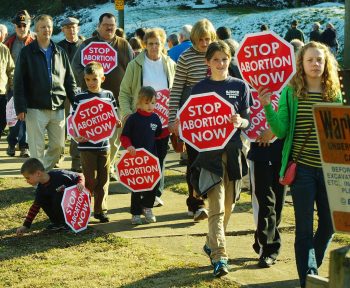
Personhood USA’s 2014 attempt to insert personhood language into Colorado law drew on this legal history, specifically limiting its new definition of personhood to the Colorado Criminal Code and Colorado Wrongful Death Act. But the proposal was nonetheless widely recognized as an attempt to ban abortion, or at least to set up a legal battle challenging Roe. In fact, Colorado had already passed laws imposing extra penalties for crimes against pregnant women, the purported purpose of the personhood amendment. “They are changing the tone, they are changing the language, they are changing the messaging to try to win,” Nash said.
Parker has chronicled laws treating fetuses as full-fledged humans in certain cases to argue that “Today, the only major area in which unborn children are denied legal protection is abortion, and that denial is only because of Roe.” He has urged the Supreme Court to address the issue at the next chance it gets.
Parker and Moore’s strategy relies on what the personhood movement’s proponents believe is a loophole in Roe v. Wade that would allow anti-abortion advocates to effectively undo the decision without a constitutional amendment or a new Supreme Court friendlier to their cause. In Roe, the justices rejected the idea of fetal personhood. Justice Blackmun wrote in his majority opinion that “no case could be cited that holds that a fetus is a person within the meaning of the Fourteenth Amendment,” noting, “If this suggestion of personhood is established, the appellant’s case, of course, collapses for the fetus’ right to life would then be guaranteed specifically by the Amendment.”
A federal bill that currently has 132 cosponsors in the House and 21 in the Senate takes a similar tack, simply declaring that “the right to life guaranteed by the Constitution is vested in each human being” and that such right includes “each member of the species homo sapiens at all stages of life, including the moment of fertilization, cloning, or other moment at which an individual member of the human species comes into being.”
Sen. Rand Paul of Kentucky, the chief sponsor of the Senate bill, signed a fundraising email for the pro-personhood National Pro-Life Alliance in November, arguing that his was the strategy that would work:
The Supreme Court itself admitted—if Congress declares unborn children “persons” under the law, the constitutional case for abortion-on-demand “collapses.”
Alabama’s Supreme Court is the first to give a serious hearing to the personhood strategy, long considered by even some anti-choice legal theorists to be a crackpot theory and a potential political and legal disaster.
As recently as 2009, Clarke Forsythe, then the president of Americans United for Life, wrote in the National Review that the so-called “personhood loophole” was an “urban legend” and those pursuing it were “heading toward a brick wall.” Forsythe argued that in 1992 Casey decision, the Supreme Court had shifted the abortion debate from the personhood of fetuses to the rights of women, and that women’s rights was therefore the ground that the anti-choice movement should be playing on. “The real challenge for pro-lifers in 2009 is to effectively address the assumption that abortion is good for women,” he wrote, presaging AUL’s revamped woman-focused messaging.
In a 2009 article for Human Life Review, attorney Paul Benjamin Linton wrote that state personhood amendments had been “drafted with breathtaking, indeed, stunning, ignorance, or even defiance, of basic state and federal constitutional principles.” The personhood strategy, Linton wrote, is not a “silver bullet” to destroy Roe, but merely a “blank” that “will not have any impact on the abortion liberty recognized in Roe.”
Even more alarming to the personhood movement’s detractors in the anti-choice movement is the possibility that a personhood challenge to Roe could create the opportunity for a Supreme Court ruling that would actually strengthen constitutional protections for abortion rights. Justice Ruth Bader Ginsburg, for instance, has said that she believes abortion rights should be secured under the equal protection clause of the Fourteenth Amendment, making the issue more clearly about the rights of women. In 2010, Austin Ruse of the Catholic Family & Human Rights Institute (C-FAM) wrote, “If a personhood amendment comes before this court, a new and terrifying decision may put the pro-life movement back a quarter century or more.”
In 2007, as the anti-choice movement’s schism over a ban on so-called “partial-birth abortion” was gaining national attention, Georgia Right to Life, which was at the time NRLC’s national affiliate, worked with legislators to introduce a state constitutional amendment defining a “person” under state law as “including unborn children at every state of their biological development, including fertilization.”
Although the Georgia amendment was based on language originally drafted as a federal constitutional amendment by NRLC, NRLC’s chief counsel James Bopp, Jr., tried to shut it down. In a lengthy, frank memo to others in the anti-choice movement, Bopp contended that such an amendment would be immediately struck down in federal courts and, if it made it to the Supreme Court, would give the court’s majority the opportunity to rewrite Roe in the way favored by Justice Ginsburg. The state-level personhood strategy, he cautioned, was “presently doomed to expansive failure.”
Instead, Bopp said, the anti-choice movement should continue its incremental strategy, which was succeeding in curtailing access to abortion while keeping the issue in the public eye. He wrote that the “partial-birth abortion” law had been a successful example of this strategy because it “forced the pro-abortion camp to publicly defend a particularly visible and gruesome practice.” Acknowledging that “most pro-lifers” believe that abortion should only be available to save the life of a pregnant woman, he warned that absolutist approaches were both legally unwise and poor public relations:
By contrast, the pro-life movement must at present avoid fighting on the more difficult terrain of its own position, namely arguing that abortion should not be available in cases of rape, incest, fetal deformity, and harm to the mother. While restricting abortion in these situations is morally defensible, public opinion polls show that popular support for the pro-life side drops off dramatically when these “hard” cases are the topic. And while most pro-lifers believe that a consistent pro-life position requires permitting abortion in only the rare circumstances where it is necessary to save the life of the mother, some pro-lifers believe that there should not even be an exception to preserve the life of the mother. Other pro-lifers advocate exceptions for rape or incest. This is an important debate to have, and we should be ready to convince the public of the need for few, if any, exceptions to laws prohibiting abortion when such laws can be upheld. However, since that is currently not the case, such a debate is premature and would undermine public support for the pro-life position.
Responding to Bopp’s memo, the conservative Thomas More Law Center, which drafted the Georgia amendment, argued that the incremental strategy had taken too long and done too little and that “after 34 years of abortion on demand through all nine months of pregnancy, it is time to rethink pro-life strategy.”
“[T]he central holding of Roe v. Wade remains the primary obstacle to any meaningful pro-life initiative that seeks to end abortion,” wrote Thomas More attorney Robert J. Muise. “To remove this obstacle, a case must be presented to the United States Supreme Court that challenges the central premise of Roe—that the unborn is not a person within the meaning of the law.”
Taking the Fight Local
When Daniel Becker launched the Personhood Alliance, he took with him Gualberto Garcia Jones, a top Personhood USA official and key thinker in the personhood movement, who says he drafted the failed Colorado personhood initiatives in 2010 and 2014. A few weeks later, after statewide personhood ballot initiatives promoted by Personhood USA in North Dakota and Colorado went down in flames, Garcia Jones wrote in an op-ed for LifeSiteNews that while he had hoped to see those measures succeed, he believed that “the statewide personhood ballot measure is dead for now.” This was a direct repudiation of Personhood USA’s strategy of introducing these measures in all 50 states.
Garcia Jones wrote that the struggling movement needed to engage in “asymmetrical tactics” by pushing through municipal personhood measures in rural areas where the movement can “control the battleground”:
These initial years of the personhood movement have taught us a lot. I believe that we now know how to fight to win against Planned Parenthood. And the key is being able to control the battleground.
When you look at electoral maps of the country, it is readily evident that majorities in almost every metropolitan area of the country are opposed to our worldview. These metropolitan areas are also the major media centers and accumulate large percentages of the voting population in every state.
Right now, fighting the abortion industry at the state level is akin to having lined up a battalion of colonists against the well-trained and well-armed redcoats. We need to start engaging in more asymmetrical tactics, and this means engaging the enemy in municipalities and counties that we know we control.
This can be done at the legislative and political level, as Georgia Right to Life and other groups have done by the endorsement of state officials, or it can be done by engaging in municipal ballot measures.
Jones noted that such municipal ordinances could affect the “many [local] powers that touch upon the personhood of the preborn, from local health and building codes to local law enforcement such as child abuse prevention.” And he hopes that, in the long run, municipal-level victories could lead to greater things. In a video presentation to the Personhood Alliance’s founding convention, he held up the example of Mexico, where 17 states have passed personhood amendments to their constitutions—leading to the arrests of dozens of women.
'Unintended and Unknown Consequences'
If personhood laws were to succeed in the courts, the legal implications would be immense and unpredictable.
The ambiguous wording of personhood measures has led to concerns that they could be interpreted to outlaw oral contraception, intrauterine devices (IUDs) and in-vitro fertilization. But birth control is not the only issue. As National Advocates for Pregnant Women’s Lynn Paltrow and Fordham sociologist Jeanne Flavin have documented, laws granting legal rights to fetuses outside the context of abortion have led to hundreds of cases of pregnant women being arrested or otherwise apprehended after suffering miscarriages or for alleged drug and alcohol use deemed to be harmful to the fetus.
In countries that completely criminalize abortion—the goal of the “pro-life” movement in the U.S.—pregnant women can be put in terrifying situations. Recently in El Salvador, a woman was sentenced to 30 years in prison for murder after suffering a miscarriage.
As Paltrow told Newsweek in 2012, “There’s no way to give embryos constitutional personhood without subtracting women from the community of constitutional persons.”
Lynn Paltrow, National Advocates for Pregnant Women
By redefining what it means to be a person under the law, personhood measures could also have a broad legal impact on issues unrelated to reproductive rights, threatening to upend everything from inheritance law to census results. In 2014, the Colorado Bar Association opposed the state’s personhood ballot measure, warning that the vaguely worded measure would have “potentially serious, unintended and unknown consequences for Colorado lawyers. … From areas of Family Law to Probate Law to Real Estate Law, as well as the explicit effect on Criminal Law and Wrongful Death statutes, this Amendment could create uncertainty and endless litigation.”
Daniel Becker, the former leader of Georgia Right to Life and founder of the Personhood Alliance, also sees the personhood issue as extending beyond abortion rights, but in a different direction. The final chapter of Becker’s 2011 manifesto, “Personhood,” is written in the form of a science fiction story set in a “post-human future” in which computers have gained consciousness, procreation has been moved to laboratories, and a “specialized sub-class of human-animal hybrids” has been developed to perform menial labor. The anti-abortion rights movement, he argues, will cease to be relevant in coming battles over biotechnology if it remains “at its heart, anti-abortion as opposed to pro-sanctity of human life.” He argues that only by embracing full “personhood” rights for zygotes and fetuses will the movement remain viable in the future.
The personhood movement, while it has hopes in the legal system, also recognizes that it won’t get far without winning hearts and minds.
Will Personhood Work?
Will the personhood movement’s strategy work?
Polling shows that the level of support for abortion rights in the U.S. depends on how you ask the question. And Gallup has found that Americans are pretty much evenly split between those who call themselves “pro-life” and those who choose the label “pro-choice.” But behind the labels is an entirely different picture. A large majority of Americans believe that abortion should be legal under all or some circumstances; only 21 percent want the procedure to be completely banned. Similarly, Pew found in 2013 that only three- in- 10 respondents favored overturning Roe v. Wade.
These numbers don’t bode well for the personhood movement. Voters in states as conservative as Mississippi and North Dakota have been turned off by personhood’s clear goal of banning abortion in all circumstances as well as the threat it poses to contraception and fertility treatments.
At the same time, the more successful anti-choice groups have managed to work within current public opinion to push through scores of state-level measures restricting access to abortion in an effort to slowly undermine Roe. These measures, many based on model legislation from Americans United for Life, restrict abortion access by such means as imposing waiting periods for women seeking care; requiring hospital “admitting privileges” for abortion providers, and then banning public hospitals from providing such privileges; or regulating the width of the hallways in clinics.
The Guttmacher Institute has calculated that between 2011 and 2014, states enacted 231 abortion restrictions, meaning that half of all reproductive-age U.S. women now live in a state that the institute categorizes as “hostile” or “extremely hostile” to abortion rights—all without passing outright bans on abortion or establishing fetal “personhood.” The anti-choice group Operation Rescue, which keeps detailed records on abortion providers in its effort to shut them down, reports that the number of surgical abortion clinics in the country has dropped by 75 percent since 1991, with 47 such clinics closing permanently in 2014. This can be partly attributed to the increased frequency of medication abortion, a practice that anti-choice groups are targeting with new restrictions. In 2005, even before the closures of the past few years, 87 percent of U.S. counties had no abortion provider.
Even as voters reject moves to ban abortion outright, anti-choice groups have found less resistance to this strategy of chipping away at abortion rights with the same goal. This contrast played out in the 2014 election, when voters in Colorado and North Dakota rejected personhood measures that they were clearly told could end legal abortion, while voters in Tennessee approved a measure giving the state government sweeping new powers to curtail abortion rights without outright ending abortion rights.
In fact, by loudly proclaiming its end goal, the personhood movement may be inadvertently helping the incrementalists who are using a different strategy to achieve the same ends. By proudly embracing the no-compromise extremes of the anti-choice agenda, the personhood movement has allowed the incrementalists to portray themselves as the political center, giving them cover for a successful campaign to undermine the right to choose. In 2014, Americans United for Life president Charmaine Yoest told Time, “Most people want to see abortion restricted in some way, even if they don’t call themselves pro-life … We’re the ones occupying the middle ground.” She might not be able to make that statement if the personhood movement was not loudly and proudly occupying the absolutist, no-compromise stance that her group believes to be too politically risky.
Even as the personhood movement provides political cover to groups like AUL, it also serves as an ever-present reminder of the goals of the anti-choice movement as a whole. While the more visible anti-choice groups may find a total, immediate ban on legal abortion politically unfeasible, the personhood movement is a constant reminder that this is the ultimate goal—one way or another.




